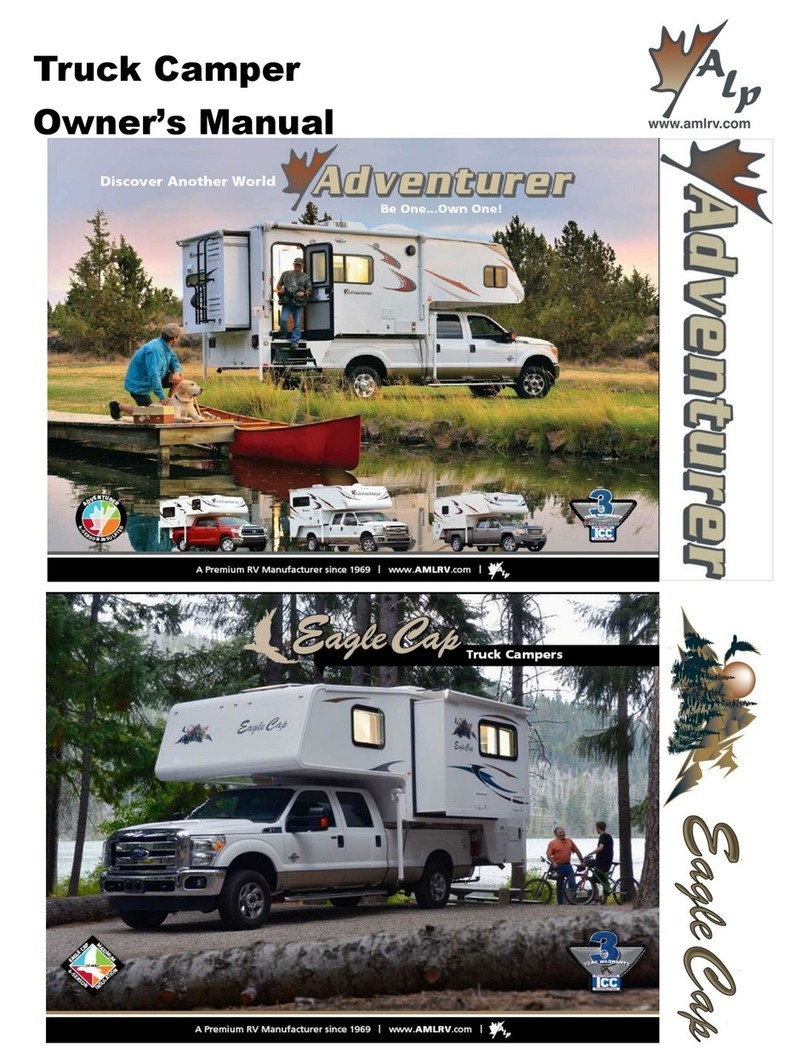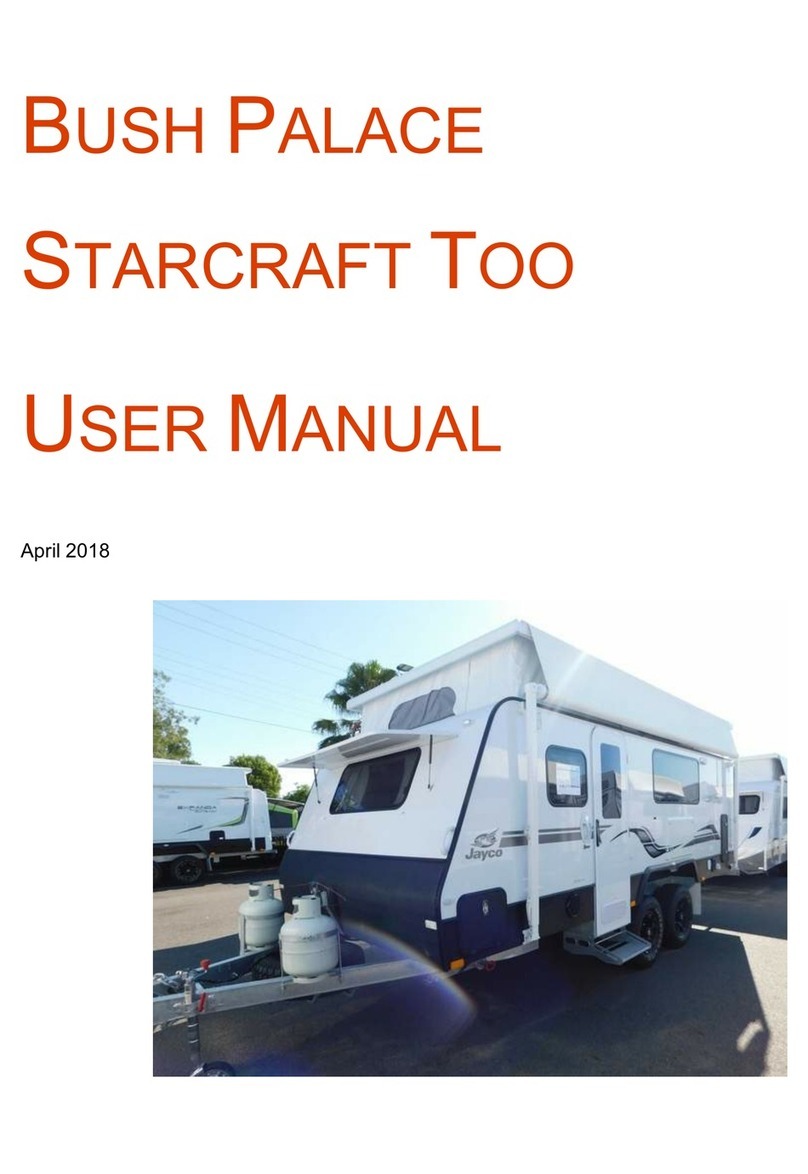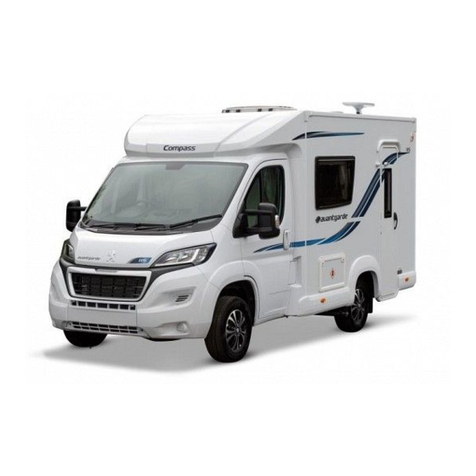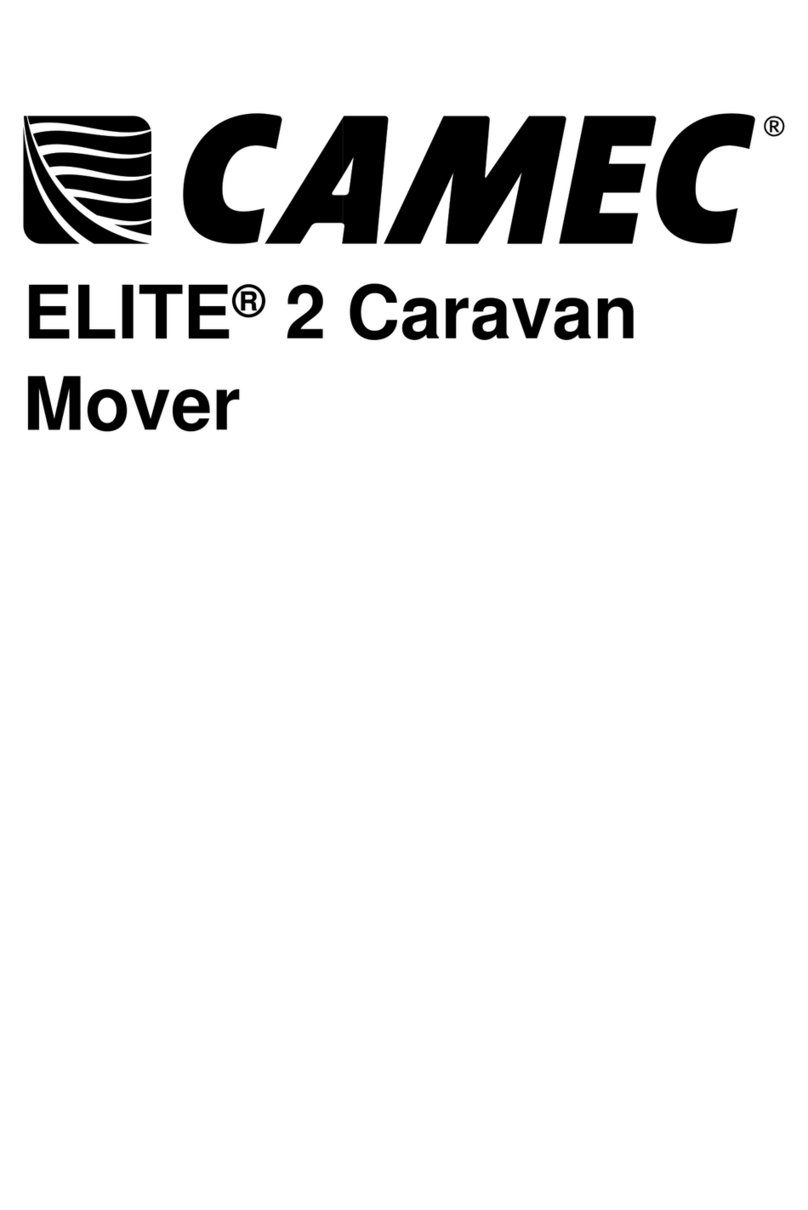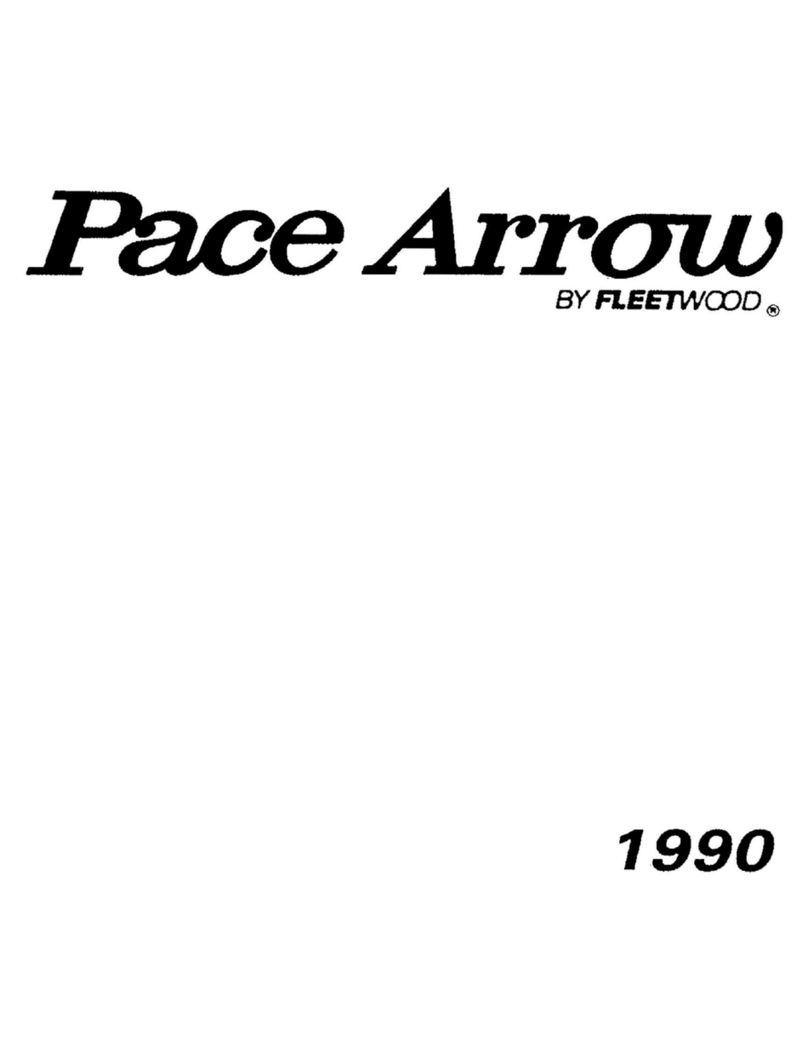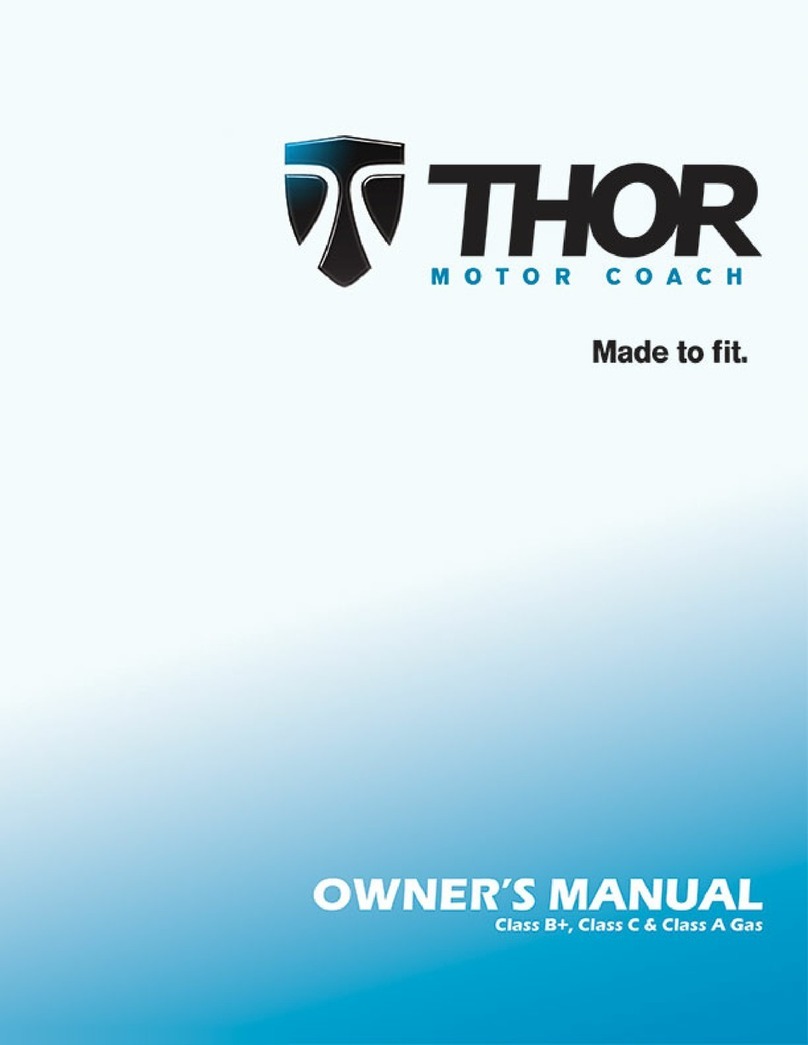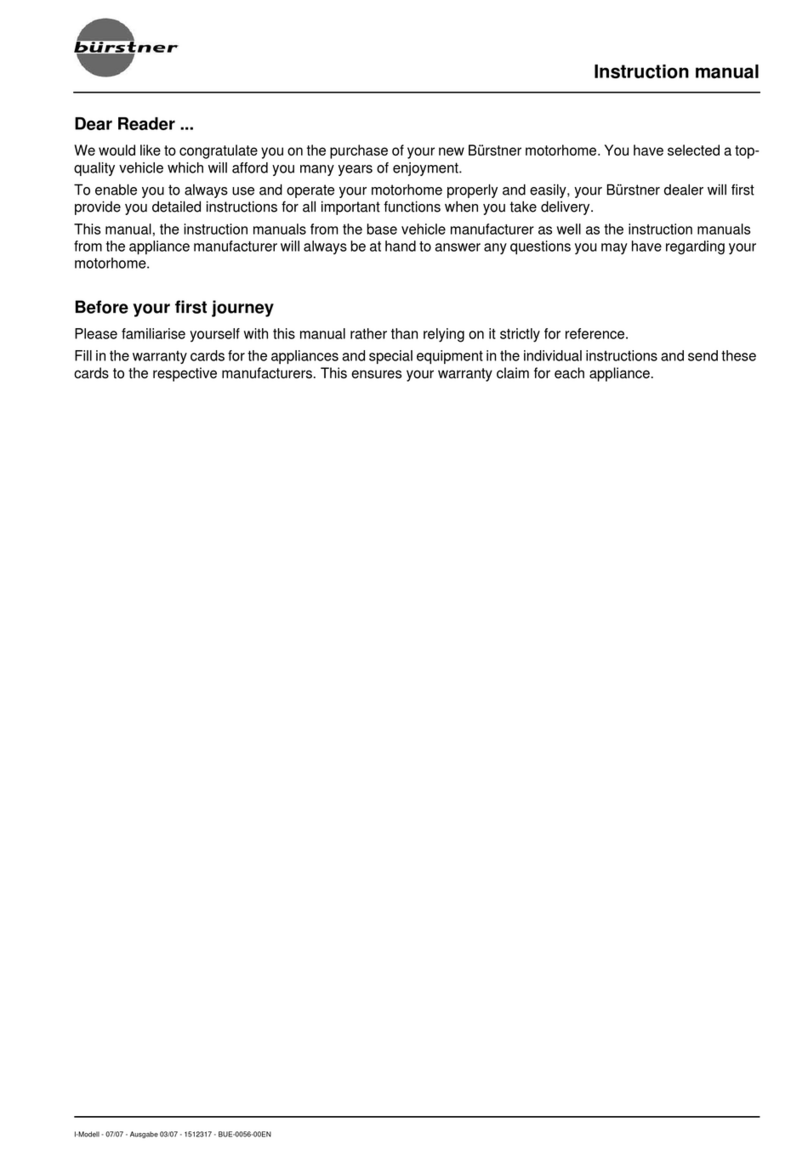Adventurer LP Eagle Cap User manual

Truck Camper
Owner’s Manual

TABLE OF CONTENTS
© Adventurer MFG Limited Partnership. All Rights Reserved
Introduction..........................................................................................................................1
Information in This Manual ..................................................................................................................1
Dealer‟s Responsibility .........................................................................................................................1
Prolonged Occupancy............................................................................................................2
Limited Warranty ..................................................................................................................2
Important Information About Your Warranty ........................................................................................2
Exclusions ..........................................................................................................................................3
Identification ........................................................................................................................4
Centre Of Gravity ..................................................................................................................5
Weight Information .............................................................................................................................6
Propane Systems...................................................................................................................6
LP Gas Safety Precautions ...................................................................................................................7
Filling LP Gas Tanks ............................................................................................................................7
Lighting LP Gas Appliances ..................................................................................................................8
If You Smell Gas .................................................................................................................................8
Using LP Gas Systems at Low Temperatures.........................................................................................8
Fire And Safety......................................................................................................................9
LPG Leak Detector ..............................................................................................................................9
Smoke Detector ..................................................................................................................................9
Carbon Monoxide ................................................................................................................................9
Electrical System.................................................................................................................10
Ground Fault Interrupter ...................................................................................................................10
Systems Monitor Panel ......................................................................................................................10
Water Pump Control Switch ...............................................................................................................11
Monitor Panel-Levels Indicators Switch ...............................................................................................11
Water System......................................................................................................................11
Fresh Water Tank .............................................................................................................................11
City Water Hookup............................................................................................................................12
Waste Water System...........................................................................................................12
Loading Your Camper Onto Your Pickup .............................................................................13
Loading the camper ..........................................................................................................................13
Tie-downs or Turnbuckles..................................................................................................................13
Electrical Connection to your truck .....................................................................................................13
Towing and Hitch systems .................................................................................................................14
Loading Cargo ..................................................................................................................................14
Carrying Capacity..............................................................................................................................14
Unloading Your Camper ......................................................................................................15
Operating Remote Control Electric Jacks.............................................................................................16
Dually Brackets .................................................................................................................................17
Camper Features .................................................................................................................17
Vents ...............................................................................................................................................17
Lighting............................................................................................................................................17
Bathroom .........................................................................................................................................17
Dinette Bed ......................................................................................................................................17
Ladder and Roof Rack .......................................................................................................................18
Cab-Over..........................................................................................................................................18

TABLE OF CONTENTS
© Adventurer MFG Limited Partnership. All Rights Reserved
Storage ............................................................................................................................................18
Appliances...........................................................................................................................18
Lighting LP Gas Appliances ................................................................................................................18
Microwave Oven ...............................................................................................................................18
Refrigerator ......................................................................................................................................18
Water Heater....................................................................................................................................18
Range / Oven ...................................................................................................................................19
Opening The Slide Out.........................................................................................................19
Opening & Closing The Slide..............................................................................................................20
Slide Out Failure ...............................................................................................................................20
Operating The Full Wall Slide .............................................................................................................20
Tent Models.........................................................................................................................21
Tent Care & Maintenance ..................................................................................................................21
Maintenance........................................................................................................................22
Maintaining Exterior And Interior Finishes...........................................................................................22
Winterization And Winter Storage ......................................................................................23
Winterizing Your Camper ...................................................................................................................24
Preparing Your Unit For Storage ........................................................................................................25
Short-Term Storage Above Freezing (Less Than 60 Days)....................................................................26
Long-Term Storage Above Freezing....................................................................................................26
General Camper Winter Storage Checklist...........................................................................................27
Reactivating the Unit After Storage ....................................................................................................27
Travel Tips...........................................................................................................................29
Some Useful Equipment to Take Along ...............................................................................................29
Troubleshooting ..................................................................................................................30
FAQ .................................................................................................................................................30
Notes...................................................................................................................................31

© Adventurer MFG Limited Partnership. 1All Rights Reserved
INTRODUCTION
ADVENTURER LP LIMITED PARTNERSHIP would like to take this opportunity to thank you for choosing one of our
truck campers. We have sought to anticipate your needs and desires with respect to convenience, style, safety
and engineering. Customer satisfaction and goodwill are of primary importance, so we have provided this manual
to assist you in understanding the proper use, operation and maintenance of the various components and
systems that have been designed into your truck camper.
Study this manual carefully, as well as the manuals included from the manufacturers for the appliances and
equipment installed in your unit. Your Dealer will take you through the unit and explain how each of the systems
is operated, making sure you understand it fully before you set out on the road.
Product improvement is a continuing process at Adventurer LP Ltd., thus we reserve the right to change
materials, components and specifications without prior notice.
In the interest of safety, your recreational vehicle has been designed and constructed to meet or exceed the
requirements of applicable Recreational Vehicle Industry Association & ANSI codes.
A warranty registration card is enclosed along with the manual. Please complete and fill out this registration card
with your Dealer, and return it to us within fifteen (15) days of purchase in order to validate the warranty.
Should you have additional questions or problems regarding operation, maintenance, service or warranty, please
contact your Dealer for assistance.
This manual has been designed to cover our complete line of Truck Campers.
Information in This Manual
Products and components in Adventurer Camper‟s may change without notice. This manual is intended to be a
guide only. Please refer to the individual component instructions and warranties in your Info-Pak.
Dealer’s Responsibility
Adventurer LP delivers the best quality in our campers to the dealer. Before shipping, every camper has been
inspected to ensure it is complete and of the best quality. As with any owner, the dealer must also inspect and
reseal units annually as necessary as they await sale.
The dealer will perform a complete inspection of the unit to see that it is free from defects. Your dealer at the
time of purchase will walk you through the camper and explain the proper usage of the following.
Appliances
Slide-out operation
RV Hookups
Electrical Systems
Loading and Unloading
Plumbing Systems

TRUCK CAMPER OWNER‟S MANUAL
© Adventurer MFG Limited Partnership. 2All Rights Reserved
PROLONGED OCCUPANCY
Your truck camper has not been designed for permanent housing or lodging. Using your camper in this manner
may lead to deterioration of the structure, interior finishes, fabrics, carpeting and drapes. Damage due to long
term use may not be considered normal use may under the terms of the warranty constitute misuse, abuse or
neglect, and may reduce your warranty protection.
LIMITED WARRANTY
Adventurer LP Ltd. Partnership hereby warrants each truck camper manufactured to be free from defects in
material and workmanship under normal service and use. The manufacturer‟s obligation under this warranty shall
be limited to repairing or replacing any part or parts therein deemed to be defective upon manufacturer‟s
examination for one year from original retail purchase from an authorized Adventurer Dealer.
Also provided is a
three year transferable limited structural warranty for Adventurer products, and a two
year transferable limited structural warranty for Eagle Cap products
, which shall become effective only if
the warranty card is properly completed and returned to the manufacturer.
This warranty shall not apply where the product is being used for rental and/or leasing purposes or has been
subject to damage caused by misuse, accident, alternation or negligence. This warranty does not cover
refrigerators, stoves, water heaters, furnace or any other components, which are protected by their respective
manufacturer‟s warranties. Also, there will be no reimbursement for transportation, gas, food or lodging.
Important Information About Your Warranty
At Adventurer LP Ltd., we would like to ensure that you enjoy many years of trouble free relaxation in your new
truck camper. We ask that you read the terms and conditions of your warranty thoroughly, and understand fully
what must be met in order for the warranty to remain valid. In order for the warranty to become effective, the
warranty registration card must be properly completed and returned to the manufacturer no later than 15 days
from the date of the original purchase from the dealer.

TRUCK CAMPER OWNER‟S MANUAL
© Adventurer MFG Limited Partnership. 3All Rights Reserved
CAUTION: Rubber Roof Repairs. Use Only Proper
Rubber Roof Caulking Sealant for skylight and all roof
attachments.
Normal maintenance is the responsibility of the owner. To keep the structural warranty in force, owners are
required, at their own expense, to bring their truck camper to their authorized dealer for regular
ANNUAL INSPECTIONS AND ANY REQUIRED SERVICE.
The following will be inspected:
Inspect under floor protection for damage, punctures and a moisture tight seal.
Inspect all entry doors, baggage and access doors, windows, tail lights, clearance and marker
lights, moldings and attachments for a moisture tight seal.
Inspect all fiberglass joint seams for proper adhesion,
Inspect all exterior and interior surfaces for proper care and maintenance (e.g. regular wash and
wax of exterior siding).
Inspect all roof moldings, trims, vents, antennas, roof racks and other attachments for moisture-
tight seal.
Owners must have all authorized factory repair depots OBTAIN FACTORY REPAIR
AUTHORIZATION PRIOR to executing any warranty repairs. Any costs associated with transporting the
vehicle to the factory or other authorized repair facility is the sole responsibility of the owner.
Exclusions
The scope of this warranty is expressly limited to only items actually constructed by Adventurer LP. Adventurer LP
therefore makes no warranty with respect to component parts constructed or assembled by other manufacturers,
including, but not limited to the LPG and electrical appliances, heaters, refrigerators, plumbing fixtures, light
fixtures, lights, entrance door and windows. These component parts may be warranted by their respective
manufacturers, and copies of such warranties are included with the camper.
This warranty shall not apply to damage caused by abuse, misuse, neglect, alteration, modification, accidents or
normal wear and tear. Nor does this warranty apply to parts made out of cloth, leather, wood, paint, or chrome
which has been affected by airborne fallout, such as chemicals and tree sap, or by road salt, hail, windstorm or
other environmental factors.
No payment or other compensation will be made for incidental expenses, including, but not limited to, towing,
telephone, transportation, lodging, travel, gasoline, loss of pay or indirect or consequential damage including, but
not limited to, loss of use of the vehicle, inconvenience, damage or injury to person or property, or loss of
revenue incurred or sustained by reason of a manufacturer‟s defect covered by this warranty. Adventurer is not
responsible to any purchaser of this recreational vehicle for any undertaking, representation or warranty made by
dealers during the course of selling this recreational vehicle, beyond those herein expressed.
As the manufacturer of the camper, which you have purchased, Adventurer LP cannot know the purpose you
have in mind for your truck and camper, nor can Adventurer LP know the GVWR of your truck. Therefore,
Adventurer LP makes no warranties or representations, express or implied, as to the performance of your truck if
the match up of your truck and camper exceeds the GVWR as specified by your truck‟s manufacturer. Specifically,

TRUCK CAMPER OWNER‟S MANUAL
© Adventurer MFG Limited Partnership. 4All Rights Reserved
there is no express or implied warranty of merchantability or of fitness for the particular match of your truck to
any particular camper.
IDENTIFICATION
Adventurer Mfg. Ltd. Partnership is a Canadian owned company with a reputation for quality and reliability. We
build all of our units with Canadian conditions in mind. Each unit is identified with the following labels or plates:
A. RVIA and ANSI labels are affixed to the exterior of each unit, usually near the
entrance door. Adventurer LP meets or exceeds these specifications.
B. A camper label is attached to the exterior of all truck campers. This label is near the entrance door, and shows
the model and serial numbers, date of manufacture and camper mass.
MFGD By
Adventurer LP Ltd. Partnership
3303 W. Washington AVE Yakima, WA 98903
DATE OF MFG.______________________
THIS CAMPER CONFORMS TO ALL APPLICABLE
U.S. FEDERAL MOTOR VEHICLE SAFETY
STANDARDS IN EFFECT ON THE DATE OF
MANUFACTURE SHOWN ABOVE
Camper Weight is ________ Lbs. Maximum When
it Contains Standard Equipment, __________of
Water,_____ of Bottled Gas, and —Cubic Ft.
Refrigerator or Ice Box With ________ Lbs. of Ice.
Consult Owner‟s Manual or Data Sheet for
Weights of Additional or Optional Equipment.
V.I.N. ___________________________________

TRUCK CAMPER OWNER‟S MANUAL
© Adventurer MFG Limited Partnership. 5All Rights Reserved
CENTER OF GRAVITY
On each Adventurer camper (left and right) sidewall is the centre of gravity sticker. The center of gravity should
be ahead of the rear axle to transfer more of the weight to the front of the truck.
When packing your camper, store heavy gear first, keeping it on or near the camper floor. Place heavy objects or
items far enough forward to keep the loaded camper‟s centre of gravity within the area recommended by the
manufacturer. Store only light objects on high shelves. Distribute weight to obtain even side-to-side balance of
the loaded vehicle.
Recommended Center of Gravity Location Zone
Center of Gravity Location under Specific Loading Conditions
mm

TRUCK CAMPER OWNER‟S MANUAL
© Adventurer MFG Limited Partnership. 6All Rights Reserved
CAUTION: Camper weights vary depending on the
dry and wet weight, plus options etc.
Weight Information
“NOTE THIS IS A GUIDE ONLY”. Please ensure that your truck is the right size for the camper you
have purchased.
The weight of your truck camper is stated on the camper‟s serial plate. This weight includes only the
STANDARD EQUIPMENT, which is listed on the specification nameplate found inside the closet of your
unit.
YOU MUST REMEMBER THAT THE ADDITION OF OPTIONAL EQUIPMENT WILL
INCREASE THE WEIGHT OF YOUR CAMPER.
This should be added to the maximum camper weight figure used to select the appropriate truck. Review your
option-listing guide for specific option weight. (Enclosed option weights insert with manual).
When the truck camper is loaded, drive to a scale and weigh the front and the rear wheels separately to
determine axle loads. The load on an axle should not exceed its gross axle weight rating (GAWR). The total of the
axle loads should not exceed the gross vehicle weight rating (GVWR). Weight ratings are given on the vehicle
certification label that is located in the glove box or on the left side of the vehicle door post or door edge.
If weight ratings are exceeded, move or remove items to bring the weights below ratings.
It is very important that you properly match your truck and camper to the weights specified by the manufactures.
Truck bed sizes and bed to cab heights vary. Make certain that there is a minimum 1 ½ in. clearance between
truck cab and camper overhead the camper should sit back in the bed 1 in. from the front rail of the truck box to
avoid damage to truck and camper
Adventurer recommends that SUSPENSION AIR BAGS AND/OR OVERLOAD SPRINGS be
installed on your truck at the time you purchase your camper. You should run with the recommend air pressure in
the bags when under load.
PROPANE SYSTEMS
The stove, refrigerator, water heater and furnace are all operated with LP Gas, which is stored in tanks in the
propane compartment of your unit. The gas is fed through a regulator that has been pre-set to the correct
pressure. DO NOT CHANGE THIS SETTING. Gas lines must be checked periodically for possible leakage. See your
RV Dealer for an annual gas (propane) test. A manufacturer‟s manual has been provided for each of the gas
appliances furnished with your Adventurer Camper. Read each of them carefully and operate the equipment in
accordance with the instructions.

TRUCK CAMPER OWNER‟S MANUAL
© Adventurer MFG Limited Partnership. 7All Rights Reserved
WARNING: CANADIAN SAFETY STANDARDS PROHIBIT OPERATION OF AN LP GAS
REFRIGERATOR WHILE THE MOTOR VEHICLE IS IN MOTION. ENSURE THAT THE PROPANE
TANK VALVE IS IN THE OFF POSITION.
WARNING: TURN OFF LP MAIN VALVE AND INDIVIDUALLY TURN OFF GAS APPLIANCES OR
ELECTRICALLY DISCONNECT AUTOMATIC IGNITION APPLIANCES BEFORE ENTERING AN LP GAS
BULK PLANT OR MOTOR FUEL SERVICE STATION.
WARNING: DO NOT FILL PROPANE CONTAINERS TO MORE THAN 80% CAPACITY.
OVERFILLING CAN RESULT IN UNCONTROLLED GAS FLOW WHICH CAN CAUSE FIRE AND
EXPLOSION. A PROPERLY FILLED CONTAINER HOLDS ABOUT 80% OF ITS VOLUME AS LIQUID.
CAUTION: LP gas is flammable and potentially
explosive. Use proper handling, lighting, and
ventilation procedures
LP Gas Safety Precautions
Historically, LP gas is a safe and reliable fuel. As with any other volatile and flammable material, common sense
dictates that LP gas be handled and used with respect and caution. Because LP gas systems are so reliable, they
are often taken for granted. Neglect can be a very dangerous habit. If the system is maintained regularly, you
can expect almost trouble free operation.
Filling LP Gas Tanks

TRUCK CAMPER OWNER‟S MANUAL
© Adventurer MFG Limited Partnership. 8All Rights Reserved
CAUTION: Butane vaporizes at 32°F and propane at
about 40°F. Choose a type of LP gas that has a boiling
point approximately 40°F lower than any temperature
you expect to encounter.
Lighting LP Gas Appliances
Detailed operating information for the LP appliances can be found in your Info-Pak. Please read and follow these
instructions.
NOTE: The distinctive odor of LP gas indicates a leak.
If You Smell Gas
Extinguish all open flames, pilot lights and all smoking materials.
Do not touch electrical switches.
Shut off the gas supply at the tank-valve(s) or gas supply connection.
Open all doors, windows and vents.
Leave the area until the odor clears.
Have the gas system checked and the cause of the leak corrected before using the system.
1. Inspect the entire LP system for leaks or damaged parts before each trip.
2. Do not restrict access to LP tanks. In an emergency the propane tank service valve must be easily accessible.
3. Be sure the tanks are securely fastened in their rack whenever they are mounted in the Adventurer Camper.
Using LP Gas Systems at Low Temperatures
Your gas system will function at low temperatures provided the system components are kept at a temperature
above the vapor point of the LP gas.
LP gas systems can and do freeze up in very cold weather. It is a common misconception that the regulator or
the gas itself freezes. Actually, it is moisture or water vapor that gets trapped in the system or is absorbed by the
gas that freezes and causes the problem. This ice can build up and partially or totally block gas supply. There are
a number of things you can do to prevent this freeze up:
Be sure the gas tank is totally moisture-free before it is filled.
Be sure the tank is not overfilled. This is also a safety consideration.
Keep the valves on empty tanks tightly closed.
Have the gas tanks purged by the LP gas service station if freeze up occurs.

TRUCK CAMPER OWNER‟S MANUAL
© Adventurer MFG Limited Partnership. 9All Rights Reserved
WARNING: THIS PROPANE DETECTOR DETECTS THE PRESENCE OF LP GAS. IT DOES NOT
DISCONNECT THE GAS SUPPLY.
FIRE AND SAFETY
LPG Leak Detector
An installed LP gas leak detector is located near the floor in the galley area. The
unit contains an alarm that will sound alerting you to the presence of low levels of
potentially dangerous LP gas that may have been released due to a range top or
oven burner flame loss, a gas piping leak, or an incorrectly adjusted appliance
burner.
Combination Smoke & Carbon Monoxide Detector
Most fire casualties are caused by inhalation of toxic fumes (smoke) from a fire
and not by flame. The combination smoke & carbon monoxide detector has
separate sensing chambers for smoke and carbon monoxide that work
independently of one another. It is battery powered and complies with UL-217,
ULC- S531, and CSA 6.19-01. It is located in the living/cooking area of your
camper. Please read the Owner‟s Manual for details on testing and caring for this
important safety device. Test the device after the camper has been in storage,
before each trip, and at least once a week during use. Turn the device
counterclockwise to remove it from the bracket.
The detector should never be disabled due to nuisance or false alarm from cooking smoke, a dusty furnace, etc.
Ventilate your camper with fresh air and the alarm will shut off.
DO NOT DISCONNECT THE BATTERIES
Replace the batteries once a year or immediately when the low battery “beep” signal sounds once a minute. The
detector uses two standard “AA” batteries, usually available at any retail store that sells batteries.
Test the operation of the detector after replacing the batteries. If the detector fails to operate with new batteries,
replace it with a new unit.
The fire extinguisher in your camper is located near the main entrance door. Read the operating instructions that
are printed on the extinguisher. You and your family should be familiar with fire extinguisher operation. Your fire
extinguisher should be replaced immediately after use or discharge.

TRUCK CAMPER OWNER‟S MANUAL
© Adventurer MFG Limited Partnership. 10 All Rights Reserved
Electrical System
Most electrical systems in your truck camper including the lighting, operate
on 12-volt. 12-volt power is supplied from the battery of the truck, or an
auxiliary battery which can be installed in the camper. In addition, your
unit is equipped with a 110-volt 25amp power supply cord, which can be
plugged into any available outlet. This current goes into the 32 amp
converter, which changes it to 12-volt before feeding it into the circuits.
This system automatically switches to batteries when disconnected from
external 110-volt, or vice versa. Auxiliary batteries are charged through
the alternator of the vehicle and/or through a built-in charger in the 32
amp converter.
NOTE: Do not install fuses with amperage ratings greater than that specified.
ELECTRICAL CONNECTION TO TRUCK
The truck electrical connector and cord may be installed by the Eagle Cap Campers, Inc. dealer, according to your
truck wiring system. With the wiring and connectors hooked-up, your truck will supply 12-volt DC power to
charge your camper battery and provide power for the 12-volt power needs while the truck is operating. See the
listing below for 12-volt connector wire colors, wire gauge and function:
Note: Do not use less than 10 gauge wire size for charge lines. Also, do not attach them to smaller
gauge wires.
Your Dealer should ensure that the wiring between the vehicle
and your unit is adequate for the demand system.
Ground Fault Interrupter
Bathroom and patio 120-volt electrical outlets are protected by a Ground Fault
Interrupter (GFI). This device is provided in compliance with ANSI A119.2/NFPA 501C and
CSA requirements and is intended to protect you against the hazards of line to ground
electric faults and electrical leakage shocks possible when using electrical appliances in the
bathroom or damp areas.
Systems Monitor Panel
The systems monitor panel incorporates controls and instrumentation concerning the electrical and fluid systems.
Some models also have switches for optional automatic water heaters and generators.

TRUCK CAMPER OWNER‟S MANUAL
© Adventurer MFG Limited Partnership. 11 All Rights Reserved
Water Pump Control Switch
This rocker switch controls the on demand water pump. The water pump is pressure sensitive and starts (with
the switch ON) when a faucet is opened, causing pressure in the line to drop. When the faucet is closed, pressure
builds in the line and the pump stops.
Monitor Panel-Levels Indicators Switch
When depressing the monitor switch, indicator lights for the black (waste), gray (sink), fresh water tank and
battery charging illuminate, indicating the existing condition of each component.
Erroneous indications when checking water levels can be caused by:
Water with low a mineral content. Level is measured by a very low electrical signal traveling through the liquid.
Some water which is low in mineral content, may not conduct the signal properly. Check the panel reading when
the fresh water tank is filled.
Material trapped on the sides of the holding tanks may give a full reading when the tank is actually empty. Use of
a spray to wash out the tank following dumping should help prevent this condition.
NOTE: If the sensor probes mounted in the tanks get coated with grease, the monitor panel may indicate
falsely or not at all. Avoid pouring grease, oils, or similar substances down drains or the toilet. If this is
unavoidable, the holding tank(s) should be washed out with a soapy water solution.
When testing approximate battery condition, first turn all lights, fans and other 12-volt equipment OFF. If the
battery is being charged the charge light will illuminate when the monitor switch is depressed. If only a weak light
is illuminated, discontinue use of all 12volt equipment until the battery can be recharged.
WATER SYSTEM
Fresh Water Tank
Filling the fresh water tank should ONLY be done if the camper is on the
truck, or if the floor is supported. Failure to do so may result in damage
to the unit.
The dual water systems in our campers supply water from either the
unit‟s storage tank or directly from a city water hookup. Your unit either
has a hand pump system or a demand water system. In those units
WARNING: WATER TANKS SHOULD
ONLY
BE FILLED WHEN THE CAMPER IS ON THE TRUCK
OR IF THE FLOOR IS SUPPORTED.

TRUCK CAMPER OWNER‟S MANUAL
© Adventurer MFG Limited Partnership. 12 All Rights Reserved
without a washroom and demand system, your camper comes with a hand pump which draws water from a
water tank. A small 12-volt water pump is available which pumps water through the hand pump. There is a
separate faucet for the city water hookup on these units. With the demand system, to draw water from the unit‟s
storage tanks, an electrically operated demand pump has an ON/OFF switch for shutting down the system while
traveling, while hooked up to city water, or when the unit is not in use.
City Water Hookup
To use the city water system, simply attach a potable water hose from a
service faucet to the city water connection. When the faucet is turned on,
water will be supplied to the unit, including the water heater.
Filling the portable water tank can be done by means of a hose or a bucket.
Periodic draining of the tank and flushing it with a tablespoon of baking soda
will keep it fresh and clean.
Hot Water Tank
If your unit is supplied with a hot water system, carefully read the manufacturer‟s operating instructions.
Following these directions will ensure an adequate supply of hot water at all times, wherever you are. The
correction of a failure, though rare indeed, is not a job for the do-it-yourselfer. There are hundreds of authorized
service centers across the country. Your Dealer is probably one of them.
WASTE WATER SYSTEM
Your truck camper may be equipped with one or more waste water
holding tanks. One is known as the grey water tank, for waste from the
shower and kitchen and bath sinks; the second is for sewage. Both have
their own drainage valves, but empty through the same outlet. To drain,
connect the outlet to a dumping station with a sewer hose and open the large
valve for the toilet tank and let it drain. Then open the smaller valve to drain the
grey water tank. Add clean water and a good deodorant chemical to keep tanks clean
and fresh at all times. When connected to a sewer in a trailer park, the toilet holding
tank valve should remain closed until the tank is almost full. Then drain
and recharge black water tank as above. This method will avoid
undesirable buildup in the tank.

TRUCK CAMPER OWNER‟S MANUAL
© Adventurer MFG Limited Partnership. 13 All Rights Reserved
CAUTION: Never raise the back of your camper
higher than the front
LOADING YOUR CAMPER ONTO YOUR PICKUP
Never raise the back of your camper higher than the front or it may tip forward, and damage to the unit may
occur. When camper bed is clear of the truck slowly drive truck forward, being careful not to hit the jacks.
To lower the camper, reverse the above procedure bringing the camper down to the bottom of each jack, and
then you can level your camper.
Loading the camper
Insert crank handle (if using manual jacks) firmly into the crank socket of the jack. Starting at the front
begin cranking.
Extend each jack no more than 4 - 6” at a time at all four corners starting with the front jacks, keeping
the camper as level as possible at all times. Repeat this process until the camper is clear of the truck
body bed by approximately 6“. (If there are two people working the jacks, one on each side, it is a very
easy task)
Slowly back the truck under the camper making sure to clear the wheel wells.
Continue backing up until the truck is within a foot of loaded position. Stop and connect the 12-volt
power cord to the 12-volt receptacle in the truck bed. Before continuing check to see that the distance
between the front of your truck and the bumper is at least 1” less than the distance between your truck
tail lights and the camper‟s side boxes. If not, add an appropriate wood shim in the front of the truck
bed before continuing.
Continue backing under the camper until the bumpers mounted on the front corners lightly touch the
front of the truck bed.
Slowly lower both rear jacks, then front jacks until the camper is resting fully on the truck bed.
Raise the jack base pads and secure in place according to manufacturer‟s directions.
If equipped with swing out brackets, lift the swing front jacks inward
Secure the camper to the truck with a set of high quality tie downs. It is RECOMMENDED that the front
tie downs be spring or shock loaded, while the rear be solid turnbuckles.
Install both the front and rear tie down as per the manufacturer‟s directions
Stow remote control or jack crank handle for future use.
Tie-downs or Turnbuckles
After loading your camper, it must be secured to your truck with a set of tie downs or turnbuckles.
Adventurer
recommends that Turnbuckles should be spring or shock loaded at the front, and solid in the rear.
We
recommend high quality tie downs or turnbuckles. The turnbuckles connect the camper eyebolts to the tie down
hardware installed on your truck. Check eyebolts, turnbuckles and bracket bolts before each trip and at frequent

TRUCK CAMPER OWNER‟S MANUAL
© Adventurer MFG Limited Partnership. 14 All Rights Reserved
intervals. Refer to the manufacturer‟s maintenance instructions supplied with the tie downs or turnbuckles for
more information.
Towing and Hitch systems
A hitch system should be installed on your truck by QUALIFIED PERSONNEL ONLY.
Loading Cargo
When loading your camper, store heavy gear first, and place down low. Distribute weight as evenly as possible
from side to side. Remember overloading or uneven loading can create serious safety hazard and may shorten
the service life of chassis components. Do not load upper cabinets with heavy items. Secure and brace stored
items so they won‟t move during travel, thereby shifting the load in the camper.
Do not load heavy items near the end of the camper or on the rear bumper. Carry only as much water as needed
for travel use to balance the load. Whenever possible, empty the waste water holding tanks before traveling.
Carrying Capacity
The number and size of storage components and liquid tank capacities are maximized for value and convenience.
If the camper operator fills all liquid tanks to capacity, and fills all storage compartments and cupboards to
maximum volume, the truck may exceed its GVWR. The operator is responsible for analyzing the conditions
under which the truck and camper will be used for each trip. After you have determined how much weight you
can safely carry and selected those items to make up that weight, make a list and keep it for future reference.
CAUTION: Towing will change the handling and
braking characteristics of your truck and camper
CAUTION: Over-tightening TIE DOWNS or
turnbuckles may result in damage to the unit.

TRUCK CAMPER OWNER‟S MANUAL
© Adventurer MFG Limited Partnership. 15 All Rights Reserved
UNLOADING YOUR CAMPER
There are presently two types of jacks used on our truck campers. They are Happi-Jac manual and Happi-Jac
electric with wireless remote models.
Load And Unload Your Camper on level ground, never on an obvious grade.
Release locking lever (Down Position) at top of jack when
cranking.
Be sure to reset locking lever (UP Position) when jacks are
not being cranked to avoid accidental extension.
WARNING: USE EXTREME CAUTION WHEN UNLOADING YOUR CAMPER IN A STRONG WIND
CAUTION: When unloading your camper be sure all
tie downs and electrical connections are disconnected
CAUTION: Do NOT leave jacks in the Unlocked
position for an extended period of time
Manual Screw Jack
Electric Wireless Remote Screw Jack
Locked
Unlocked

TRUCK CAMPER OWNER‟S MANUAL
© Adventurer MFG Limited Partnership. 16 All Rights Reserved
Operating Remote Control Electric Jacks
NOTE: Do not over-extend or over-retract jacks. Each jack has built in stops. If excessive force is applied
against the stops, damage to the jacks may occur.
Electric jacks need 12-volt automotive battery power to operate. The camper battery must be charged and in
good condition. If the battery is too low to operate the jacks, charge the battery before using jacks. If the camper
is on the truck, starting the truck‟s engine will supply power to the jacks as long as the 12-volt electrical cord is
connected. If no power is available, use the manual override operation noted below.
NOTE: Do not use the electric jacks to raise or lower the camper using only 120-volt power. The converter‟s
charger will be damaged if the jacks are operated with 120-volt power through the 12-volt converter without an
automotive battery or with a low battery.
A well charged battery in good condition is required.
NOTE: Before operating the remote control electric camper jacks, be sure to read and understand the operating
instructions that were provided with your camper pertaining to their safe operation.
The jacks are operated with a hand held remote control. To activate, locate and press the remote control into the
receiver, located inside the camper at floor level, near the entry door. A light on the face of the control switch will
illuminate when activated. The switch is on a time delay that will automatically shutoff 10 minutes after
activation. After use, store the remote unit in a secure place away from access by children.
To lift camper follow these steps:
Press and hold the “ALL JACKS EXTEND” button. All four jacks simultaneously extend until they touch the ground.
Release button. Check to make sure that all jacks are touching the ground. If not, use the jack buttons to extend
each jack individually until all four jacks are touching the ground.
Extend front jacks first. Extend front jacks so camper is 4” higher in front than in the rear.
Once the camper front is higher than the rear, press and hold the “ALL JACKS EXTEND” button. Release the
button when the camper is at the desired height. MAKE SURE THE FRONT OF THE CAMPER
STAYS HIGHER THAN THE REAR.
Use the individual jack buttons to adjust an individual jack. Press and hold the extend or retract buttons for the
individual jacks as needed to keep the front of the camper 4” higher than the rear, to prevent tipping over the
camper. Keep all corners within 4” of level with each other.
NOTE: If you are going to leave the camper on your truck disconnect your tie downs before leveling your
camper with the jacks.
To lower camper follow these steps:
Retract rear jacks first so the camper is 4” lower in the rear than in the front.
Once the camper has the rear lower than the front, press and hold the “ALL JACKS RETRACT” button and retract
until the camper is at the desired height.
Use the individual jack buttons to adjust an individual jack. Keep all corners within 4” of level with each other.

TRUCK CAMPER OWNER‟S MANUAL
© Adventurer MFG Limited Partnership. 17 All Rights Reserved
TIP: Use plywood pads under each jack to keep from sinking in the ground or asphalt. For added safety and
stability, support the camper floor with blocks and use camper jacks to stabilize.
Dually Brackets
SWING-OUT BRACKETS (OPTIONAL)
To load or unload campers on dual rear wheel trucks, swing-out brackets are installed on the front jacks to clear
the fender. To operate, follow the steps below:
1. Lift jack from the travel notch locked position and swing outward from the camper body.
2. Position jack so when camper jack is lowered, the notch and raised tab engage to prevent rotation.
3. Repeat the process for the other front mounted jack.
4. Follow the standard camper loading and removal procedures below.
NOTE: Keep children and animals away from the area when raising or lowering the camper. Avoid putting any
part of your body under the camper during the procedure.
CAMPER FEATURES
Vents
All exterior vents and louvers provide air circulation. Ensure that these vents are not blocked, as equipment
damage, or hazards to occupants may result.
Lighting
Your camper is equipped with exterior lights to conform to state and federal regulations. It is important not to
alter the lights or reflecting markers. Replace any burned out bulbs or damaged parts as soon as possible.
Bathroom
The toilet is designed to flush with a minimal amount of water and still provide for proper disposal and odor
control. Toilet chemicals are available at most RV retail locations. Review the booklet supplied with your toilet
for proper operation and maintenance.
Dinette Bed
All Campers come equipped with a dinette that will convert into an additional sleeping area. Your dealer will
provide instruction on the proper conversion of this area.
Remove or fold table pedestal or leg
Place filler panel (table) on the supports of the seat platforms
Arrange seat and back cushions to provide a full mattress across the new bed area.
This manual suits for next models
6
Table of contents
Other Adventurer LP Motorhome manuals
